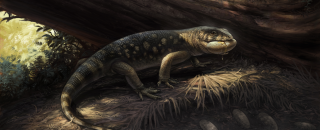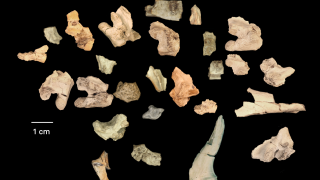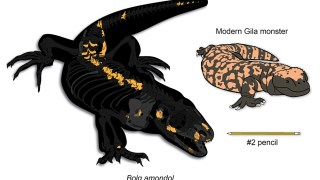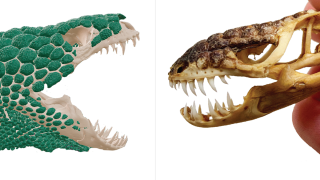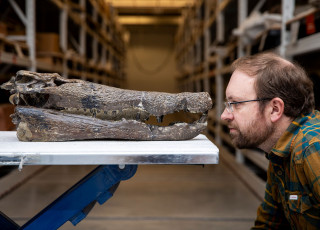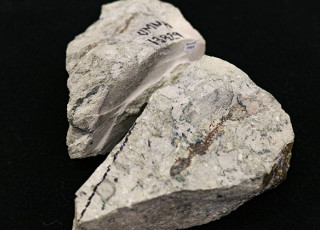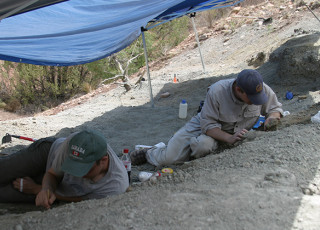New Monstersaur Honors Tolkien's Ruthless Goblin Prince: Meet Bolg
By Olivia Barney
A new monstersaur discovery is always thrilling — the image of large lizards dominating Utah’s prehistoric geography feels like a fantasy story come to life. And to long-time fantasy enthusiasts, a recent discovery found in the Kaiparowits Formation of Grand Staircase-Escalante National Monument is sure to become a fan favorite. In an ode to J.R.R. Tolkien, the “father of modern fantasy,” a new taxon of these formidable reptiles has been named after an equally formidable character from Tolkien’s beloved novel, “The Hobbit.”
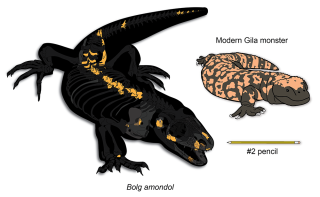
Size comparison of the holotype specimen of Bolg amondol (UMNH VP 16266, left, Natural History Museum of Utah / Bureau of Land Management) and a modern Gila monster (Heloderma suspectum, right). Gold: preserved skeletal elements. Light gray: reconstructed elements based on preserved material. Dark gray: missing skeletal elements, based off of publicly-available rendered CT scans of Heloderma horridum available on morphosource.org (UF:Herp 153328).
Meet Bolg amondol, a monstersaur that lived during the Late Cretaceous Period alongside many of the dinosaurs we know and love: ceratopsids (horned dinosaurs), hadrosaurs (duck-billed dinosaurs), and tyrannosaurids, to name just a few. A monstersaur is a member of a group of bulky lizards that includes living species like gila monsters and bearded lizards, as well as their extinct relatives. The newly discovered Bolg is distinct from other monstersaur species thanks to a combination of anatomical features in the skull backbone, and tail, as well as a unique characteristic of bony armor (osteoderms) fused to the cheekbone (jugal).
While this may not sound revolutionary to those without a specialization in paleontology, it’s different from other large-bodied lizards of the time. Hank Woolley, Ph.D., from the Natural History Museum of Los Angeles County’s Dinosaur Institute, published these findings with co-author Randall Irmis, Ph.D., from the Natural History Museum of Utah, and several other colleagues from the Natural History Museum of Los Angeles, Colorado State University, and University of Central Oklahoma.
Their discovery came unexpectedly. The specimen was collected in 2005, so why is it just now making headlines? Sometimes it just takes the right person asking different questions. “Although we knew the specimen was significant when it was discovered back in 2005,” said Irmis, “it took a specialist in lizard evolution, like Hank, to truly recognize its scientific importance and take on the task of researching and scientifically describing this new species.”
Why the Ode to Tolkien?
Bolg is a fitting name for a faunivorous (animal-eating) creature. For those unfamiliar with The Lord of the Rings universe, Bolg is a goblin prince (son of Agor) who makes an appearance in “The Hobbit” — his character is described as merciless, murderous, and cruel.
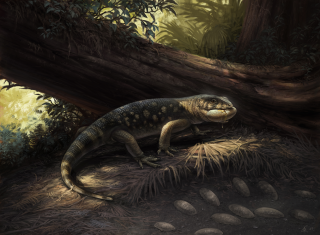
Artistic reconstruction of Bolg amondol, depicted raiding an oviraptorosaur dinosaur nest amidst the lush Kaiparowits Formation habitat. Art by Cullen Townsend
Bolg led troops into the Battle of the Five Armies, where he ultimately died. According to Tolkien, the name Bolg means “strong,” but Bolg wasn’t just a character that possessed immense power; he was also highly intelligent. Bolg was a warrior, a prince, and a menace to be feared and respected. For an armored, animal-eating lizard that grew to a minimum of three feet from tip to tail, all the adjectives ascribed to the goblin prince seem to apply equally well.
But aside from the formidable foe’s flashy physical features, the discovery of Bolg amondol is newsworthy for more important reasons: it changes our understanding of lizard communities during the Late Cretaceous and provides insights into the early evolution of gila monster ancestors.
Bolg Calls Paleontologists to Ask New Questions
Despite a roughly 110-million-year history, much of the evolutionary history of Monstersauria remains a mystery. An abundance of specimens throughout Asia have helped shape much of what we know, but comparatively few specimens have been found in North America. In fact, our current understanding of the Monstersauria clade relies on fewer than fifteen described species, a limited selection which demonstrated a surprisingly diverse array of body sizes and anatomical features.
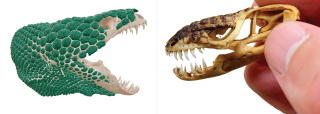
LEFT IMAGE: Publicly available rendered CT scan of Heloderma horridum (UF:Herp:153328) from Morphosource.org used for comparison to Bolg amondol, with mound-like, polygonal osteoderms in green. RIGHT IMAGE: Skull of the modern monstersaur Heloderma horridum (LACM 159136), from the herpetology collection at NHMLAC, used for comparison with Bolg amondol.
In general, monstersaurs are larger lizards with blunt snouts and conical teeth — and even though all living species are found in North America, only a handful of species from the continent document the early evolutionary history of the group. Though differences of opinion exist on the exact evolutionary relationships of these species, the discovery of Bolg sheds additional light on the prehistoric ecosystem in which they lived. Bolg is thought to be faunivorous and lived alongside two other similar species. For three large-bodied faunivorous lizards (and a plethora of faunivorous dinosaurs and crocodyliforms) to co-exist in the Kaiparowits Formation suggests a thriving and stable ecosystem — with plenty of food to go around. Based on what we know about modern lizard communities, it’s likely that these monstrous hunters favored separate microhabitats or were active at different times, limiting competition despite their interest in similar prey.
Collection Research Continues to Illuminate Utah's Diverse Ancient Life
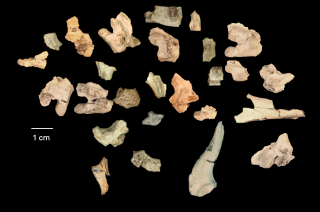
Identified bones belonging to Bolg amondol (Specimen UMNH VP 16266, Natural History Museum of Utah / Bureau of Land Management). They are not much to look at, but they are jam-packed with valuable information on the anatomy and lifestyle of Bolg amondol.
Though museum collection spaces are sometimes stereotyped as dusty, forgotten places, the truth is quite the opposite. As with many natural history museums, NHMU is an active research institution, so the museum’s paleontology collection isn’t a glorified storage unit. Instead, it’s a space where staff, students, volunteers, and visiting researchers can care for fossils and conduct new research. It was this reevaluation of collection specimens that led to Woolley’s breakthrough research on Bolg amondol.
In the conclusion of their recent publication, Woolley, Irmis, and colleagues write that the discovery “offers a clearer picture of monstersaurian richness during a crucial piece of their evolutionary history and invites us to continue to scrutinize historical collections and build new collections in the effort to uncover hidden biodiversity in a fragmentary fossil record.”
As we continue to investigate the mysteries of prehistoric life within collections and in the field, Bolg, our Cretaceous lizard prince, reminds us to ask new questions and to approach preconceived truths with curiosity. You never know what you might uncover.
Field collection of the specimens described in this study was conducted under paleontological permits issued by the Bureau of Land Management (BLM). This study was funded by the BLM, National Science Foundation, the Natural History Museum of Los Angeles Dinosaur Institute, and the University of Utah.
1 of 4
